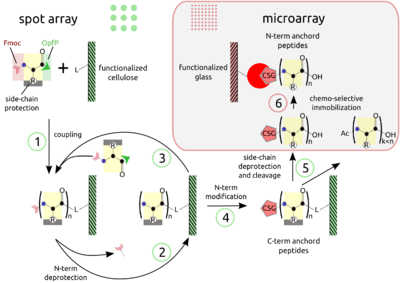Molecular Recognition Laboratorium: Difference between revisions
From OpenWetWare
Jump to navigationJump to search
Victor Tapia (talk | contribs) |
Victor Tapia (talk | contribs) |
||
| Line 101: | Line 101: | ||
<br> | <br> | ||
[[image:Macro_to_microarrays_of_peptides.png|400px]][[image:Fmoc-spotting.png|400px]] | [[image:Macro_to_microarrays_of_peptides.png|400px]][[image:Fmoc-spotting.png|400px]] | ||
PEPTIDE ARRAYS The basic point of this technology is the simultaneous display of a systematic collection of peptides on a planar support, on which numerous bimolecular interaction assays can be carried out under homogeneous conditions. The combination of SPOT peptide synthesis (step 1 to 4) with appropriate immobilization techniques on glass supports (step 5 and 6) is wide spread. The SPOT technology provides low-scale but high-throughput synthesis, while immobilization of pre-synthesized peptides offers the benefit of a "chemical" purification step and flexible array design. Additionally, the glass support is compatible with fluorescence detection and offers the possibility to miniaturize binding assays. Beyond economy, the later point is essential for quantitative measurements at the steady-state of binding activity, as has been described by Ekins [Ekins 1998] and can be proven by the mass-action law. | |||
}} | }} | ||
<br> | <br> | ||
===Structural Modularity in Protein-Protein Recognition=== | ===Structural Modularity in Protein-Protein Recognition=== | ||
FIGURE {{hide| | FIGURE {{hide| | ||
Revision as of 05:08, 19 February 2009
Contact Information
Molecular Recognition Laboratorium,
Institute für medizinische Immunologie
CHARITÉ - UNIVERSITÄTSMEDIZIN BERLIN
Hessische Str. 3-4 D-10115 Berlin, Germany phone +49-30-450 524092 fax +49-30-450 524942 mail annette.hayungs@charite.de web charite.de
Group Leader
Rudolf Volkmer
Tel.: +49 30 450 524 267 Fax: +49 30 450 524 942 E-Mail: rve(at)charite.de
Group Members
- Bernhard Aÿ, Postdoc
Tel.: +49 30 450 524 254 Fax: +49 30 450 524 942 E-Mail: bernhard.giese(at)charite.de
- Prisca Boisguérin, Postdoc
Tel.: +49 30 450 524 254 Fax: +49 30 450 524 942 E-Mail: prisca.boisguerin(at)charite.de
- Zerrin Fidan, Doktorandin
Tel.: +49 30 450 524 285 Fax: +49 30 450 524 942 E-Mail: zerrin.fidan(at)charite.de
- Annette Hayungs - Secretary
Tel.: +49 30 450 524 092 Fax: +49 30 450 524 942 E-Mail: annette.hayungs(at)charite.de
- Marc Hovestädt - Doktorand
Tel.: +49 30 450 524 254 Fax: +49 30 450 524 942 E-Mail: marc.hovestaedt(at)charite.de
- Ines Kretzschmar - CTA
Tel.: +49 30 450 524 253 Fax: +49 30 450 524 942 E-Mail: ines.kretzschmar(at)charite.de
- Christiane Landgraf - CTA
Tel.: +49 30 450 524 253 Fax: +49 30 450 524 942 E-Mail: chl(at)charite.de
- Carsten Mahrenholz - Doktorand
Tel.: +49 30 450 524 278 Fax: +49 30 450 524 942 E-Mail: carsten.mahrenholz(at)charite.de
- Judith Müller - Doktorandin
Tel.: +49 30 450 524 046 Fax: +49 30 450 524 942 E-Mail: judith.mueller(at)charite.de
- Rolf-Dietrich Stigler - IT- u. Sicherheitsbeauftragter
Tel.: +49 30 450 524 268 Fax: +49 30 450 524 942 E-Mail: rolf.stigler(at)charite.de
- Víctor Tapia - Doktorand
- Lars Vouillème - Doktorand
Tel.: +49 30 450 524 254 Fax: +49 30 450 524 942 E-Mail: lars.vouilleme(at)charite.de
Research interest
Technological Development of the Peptide Array Technologies
FIGURE
PEPTIDE ARRAYS The basic point of this technology is the simultaneous display of a systematic collection of peptides on a planar support, on which numerous bimolecular interaction assays can be carried out under homogeneous conditions. The combination of SPOT peptide synthesis (step 1 to 4) with appropriate immobilization techniques on glass supports (step 5 and 6) is wide spread. The SPOT technology provides low-scale but high-throughput synthesis, while immobilization of pre-synthesized peptides offers the benefit of a "chemical" purification step and flexible array design. Additionally, the glass support is compatible with fluorescence detection and offers the possibility to miniaturize binding assays. Beyond economy, the later point is essential for quantitative measurements at the steady-state of binding activity, as has been described by Ekins [Ekins 1998] and can be proven by the mass-action law.
Structural Modularity in Protein-Protein Recognition
FIGURE
Selected Publications
bbl




